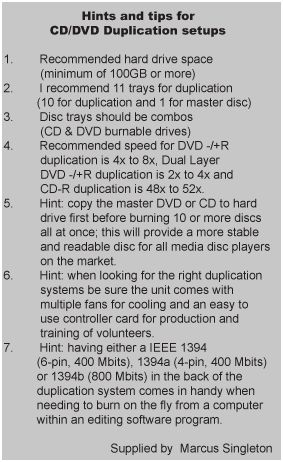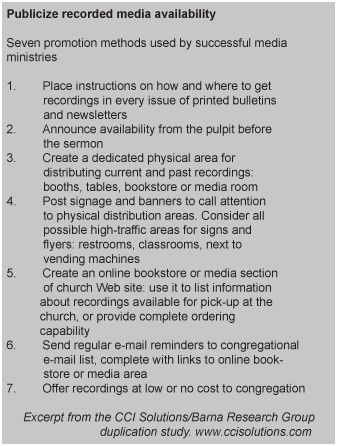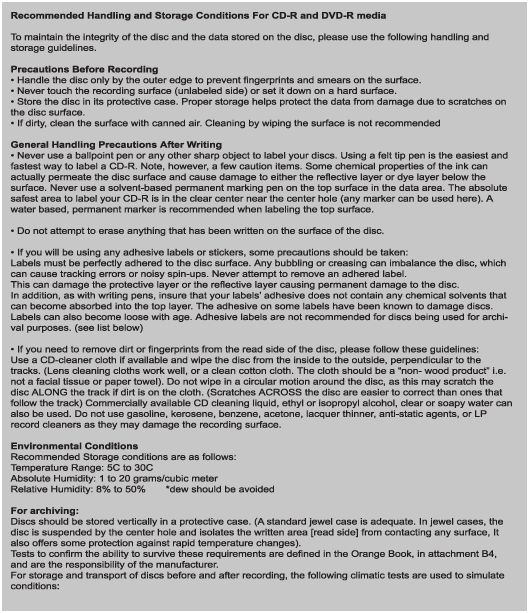Duplication in the New Media Age
Considerations for your Duplication Ministry
New media: ultra-portable, easily consumable. Practicality at it’s best, for those starting a duplication ministry. It has never been easier to duplicate and distribute your services. It has also never been more difficult.
One of the challenges for a duplication ministry lies in knowing what standard to go with. The pattern is that the standard for recorded media is set and then re-set as the next evolution comes along. The phonograph gave way to cassette tapes. Then the cassette gave way to CDs. Now the CD is giving way to downloadable files, which bring in a whole new set of variables as far as portability. As a content distributor, it’s difficult to know what standard to go with, seeing as the shelf life for standard formats is decreasing rapidly.
The prospect of starting up a duplication ministry does not have to be a daunting task, but it does require research and attention. Especially as there are presently several formats to choose from, and more popping up all the time. The good news is that more format options inevitably mean more opportunities to reach out to additional consumer demographics. Perhaps some people want to listen to a cassette tape of the service in their car, while others wish to grab a file from the web when they get home. Some people are familiar and comfortable with CDs and so they stick with them. Although, it’s safe to say that 8-tracks are pretty much history.
As it is with starting up any technical ministry, the ends justify the means. Houses of worship would do well to conduct some research with their congregations to determine what format their people are comfortable with.
What do people want?
How is a church supposed to see ahead of the curve and develop a duplication ministry that works?
When you factor in cassettes, CDs, DVDs, USB drives and portable devices to carry around downloaded files and archived streams, the possibilities start piling up. Unfortunately, so do the potential costs.
Houses of worship, being time-honored distributors of content, have recently had to make some blind predictions as to what makes the most sense for their duplication ministries. In order to choose the best solution, should houses of worship be prepared to purchase products with a shelf-life of five years (or possibly less) from here on into the future? The answer is going to end up being a series of different elements based on the demographics of their congregations.
In 2007, CCI Solutions, a company based in Olympia, Washington developed an in-depth duplication study in partnership with The Barna Group, to better understand which methods churches use to duplicate and distribute their content.
“We wanted to get some intelligence on where the end user was heading.” explains Mark Bradley, Director of Recording Media at CCI Solutions. “We sell a lot of blank media supplies, duplication, things like that. In order for us to be able to look into the future, we need to know if church goers were desiring to go mostly with a digital download, or if they prefer to get their messages on CDs and DVDs.”
 Let’s pretend for a minute that your church has already set up a CD duplication ministry. The question to ask is, does anyone know it exists? One of the most intriguing findings in the CCI/Barna research- many congregants are not even aware that their church offers recordings of the services.
Let’s pretend for a minute that your church has already set up a CD duplication ministry. The question to ask is, does anyone know it exists? One of the most intriguing findings in the CCI/Barna research- many congregants are not even aware that their church offers recordings of the services.
Highlights from the survey indicate that:
• 3 in 4 churchgoers have never gotten a recording from church
• 1 in 4 does not know if the church offers recordings
• 1 in 4 is not sure how to get them, if offered
• 1 in 4 doesn’t know if they are available only at church, online, or both
If you are already running a duplication ministry, how is it being promoted to your people? Do they know about it, and do they know where to get copies of the media? Are you conscious of the demographic of your congregants to give more people what they want?
If you are in the midst of starting up a duplication ministry, have you polled your congregants to find out what format they prefer?
Knowing what format your people want is probably the most important thing to consider, as it will determine what duplication gear you are going to buy, or stick with, if you have already purchased equipment.
For example, if you ascertain in your research that your people want a CD copy of the service to go home with, then that gives you a solid framework to build from. If you know that they prefer a CD with a printed label for easy identification, then that clarifies even more. Some may prefer cassettes. The point is, knowing what the need is and fulfilling it is unquestionably a large part of the battle.
What you will probably find, especially if your services cater to a wide spectrum of age groups, that there will be various formats that your congregation prefers.
DUPLICATION OPTIONS
For each of the methods of duplication, there are unique sets of idiosyncratic challenges and differences. Hopefully your church will have already sussed out which solution works best for your congregation before deciding to buy any gear. The trick is, the appropriate solution may be to not just have one duplication solution.
The most well known used duplication formats out there are cassettes, CD/DVD, USB/Flash drives and downloadable media. Cassettes are still used as a duplication method, but all the same, they have been left out of the following list and newer formats have been listed for the purposes of this discussion.
CDs, USB and Downloads
It is not altogether surprising that, as per the 2007 CCI/Barna survey results, a higher percentage of congregants are still looking to get content on a CD or DVD from the church rather than downloads. CDs still have the advantage of being playable in vehicles, somewhat portable devices, home stereos and computers including laptops. The file format used for CD audio is also transferable to portable devices like cell phones and iPods, so that presents another advantage.
Of course, with CDs and DVD duplication, there is a time consideration. People generally do not want to wait for very long after church to get their content.
“We call the disk right after the service ‘Disk on Demand’.” states Bradley. “The church is going to need to do some pre-printing before the service, to make sure that those disks can be produced fairly quickly for people to receive. We found in our survey that people are not willing to wait around an hour to get the message. It’s our opinion that up to 10 minutes is acceptable.”
Bryan Getz, who is Product Manager of a new line of duplicators called Discproducer from EPSON, thinks that there is still much life left in CD and DVD media. “While new media, like Pay-Per-View and downloading movies provide more options, disc still has the ability to make an impact and draw attention due to its size and label graphics. We believe people still want to have a physical DVD/CD.” he says.
When we factor duplicating USB sticks into the discussion, it brings up some other intriguing points for consideration.
“For something on demand immediately after the service, at this point [USB is] not a means to do that under the 10 minute time frame.” Bradley points out. “There is a transfer that has to happen; you’ve got to get a recording onto the USB stick first, in order to make multiple copies. What happens is, if you take a recording on a flash card, you have to put that into a computer and then transfer that over onto a USB drive. There are USB duplicators out there and we’ve sold some, but as far as taking a flash card, putting it into the duplicator and making copies onto a thumb drive, there isn’t a solution currently available to be able to do that.”
“Keys are certainly popular, but a bit more expensive.” states Getz. “Some service bureaus handle both discs and keys. Another issue is the small form factor makes it hard for messages to stand out.”
This gets back to the point of knowing what it is your people want. Are they looking for portability first? Do they care about labels and artwork? If so, USB may not be the best solution. 
“A big issue with Thumb drives versus CD is the ability to identify the content from a print standpoint,” Bradley says, “A CD or DVD allows you a large area for printing that can be full color, high resolution, really gorgeous print. You can talk about the ministry, it can direct people to the website or physical address- there’s a lot of promotional space to communicate. On a thumb drive, usually it’s one color and it’s a very small space.”
Of course, there is potential demand for USB sticks as an extension of a duplication ministry.
“Some of the larger ministries are starting to buy USB thumb drives,” Bradley continues. “The application that they are using them for is some series’, conferences and bible readings, because the attendees of the conference or the service like the portability of USB sticks; they like the size, and usually they are going to store more content on it.”
Are USB keys going to become a realistic alternative to CD/DVD media? Most likely not. As Aaron Pratt, Director of Marketing for Microboards Technology, a well-known duplicator manufacturer states, “In some places, USB is great because it’s rewritable, large capacity, and fits in your pocket. But CD and DVD still have their advantages. Because it is not re-writable and very stable, it is optimal for content that has long-term value. And even when Flash’s cost-per-megabyte drops below CD/DVD, it will be only because Flash’s capacity has increased. Cost-per-unit will be CD/DVD media’s strength for many years. So as a distribution medium, CD/DVD is still the winner.
“The key for churches is to recognize the need,” Pratt continues. “A flash duplicator is probably not the answer for distributing live worship services, so it is not analogous to CD/DVD. Why? Because your congregants that want the content of your service on flash want it on a very proprietary type of flash, namely their iPod. Instead, this technology will be very practical for sharing documents and information that needs to be edited or overwritten. That could include anything from financial plans for the leadership team to class study materials.”
As per the CCI/Barna survey results, predictably the younger congregants were more comfortable with a downloadable version of the service to access upon returning home. So in essence, the percentage of members with a preference for CD and DVD media may lessen as the younger generation starts representing the higher numbers of people in attendance.
This is something to keep an eye on. There will be a time in the foreseeable future when CD decks will no longer be provided in automobiles. This is already happening with newer models; they have auxiliary ports for mobile devices, and on-board hard drives instead. And when is the last time you saw someone on the subway with a Discman?
If you set yourself up to have the services available for download from the web after a service, then you should concentrate on developing a web infrastructure that allows downloading, ideally from an organized online catalogue. As an extension of this, you could provide a forum online for people to download the service and then discuss different aspects of what they had learned. It would be a good idea to also have the downloads available in a variety of file formats, to accommodate various platforms. The more options you provide users, the better chance you will not leave anyone out.
 Closing Considerations
Closing Considerations
Once you have collected the appropriate results from surveying your people, the next step is to start pulling together the components to accommodate their various needs. It may be a good plan to prepare for multiple duplication solutions to accommodate your demographics.
“The best examples I have seen of duplication services from churches is making the content available as easily and cheaply as possible, and in as many formats as possible,” Aaron Pratt remarks. “Sometimes that means even offering cassette tapes if you have congregants that still need it.”
This would also mean trying your best to future-proof for expansion. The good news is, a lot of these hard costs are coming down.
Marcus Singleton is a Media Director who has been directly involved in duplication ministries. “The cost per CD/DVD media has gone down over the years and the duplication systems that are built for them are bundled together for overall cost savings. Do your homework on costs, manufacturers, and what other houses of worships are currently using in your area.” he suggests.
“Some of the newer equipment in duplication systems and printing systems have become a lot more reliable as far as operation, reject rates, error detection… they are quite a bit faster, and some of the cost for printing has come way down just recently.” Mark Bradley asserts. “It’s a good opportunity for churches to take a look at their current systems, how are they working for them, and are they cost effective. For instance, they could be paying 35 cents a disc just for the printing, and some of the newer systems that are out now can get those printing costs in the 10 – 20 cent range.”
“Another important area to look out for in today’s houses of worship is the ROI (Return On Investments) on future CD/DVD duplication systems.” Singleton says. “What is your current budget for duplication systems? Do you currently have the staff or volunteers to handle the increase in workload? What is the return ($$$ monies, new members, spreading the gospel, etc…) your ministry is looking for after the purchase of these systems? How do you plan on funding this department to keep up with the supply and demand chain of the ministry?”
Even though the current cost and the simplicity is making duplication systems more effective to get underway, there are still several considerations to take into account. The best bet is to keep communication open with your congregation so that you can anticipate future development. Have a solid plan in mind for your duplication ministry. Keep current with technical educational resources. And ask around- what are other churches doing? What is working or not working for them?
Putting all of these ideas together will ensure that you plan to effectively reach out with your duplication setup to further expand and develop your ministry.
Kevin Rogers Cobus is Executive Editor of Technologies for Worship Magazine. He can be reached at krc@tfwm.com For more information about the CCI Solutions/Barna Ressearch Group duplication study check:www.ccisolutions.com




